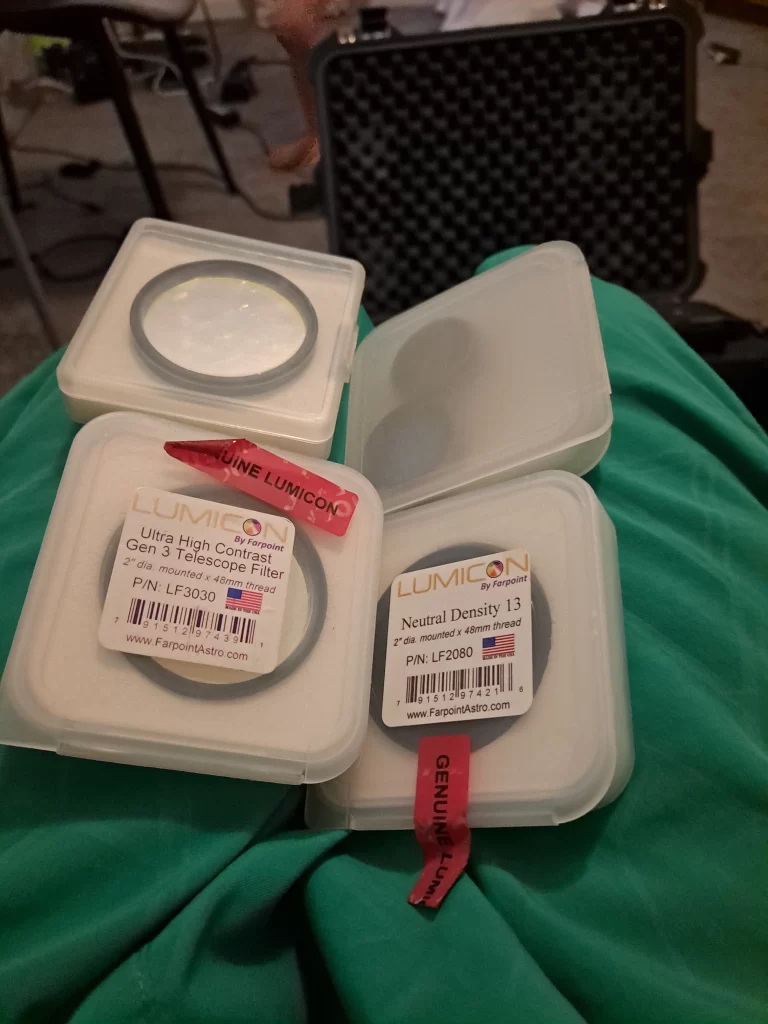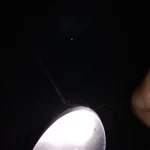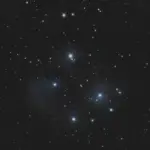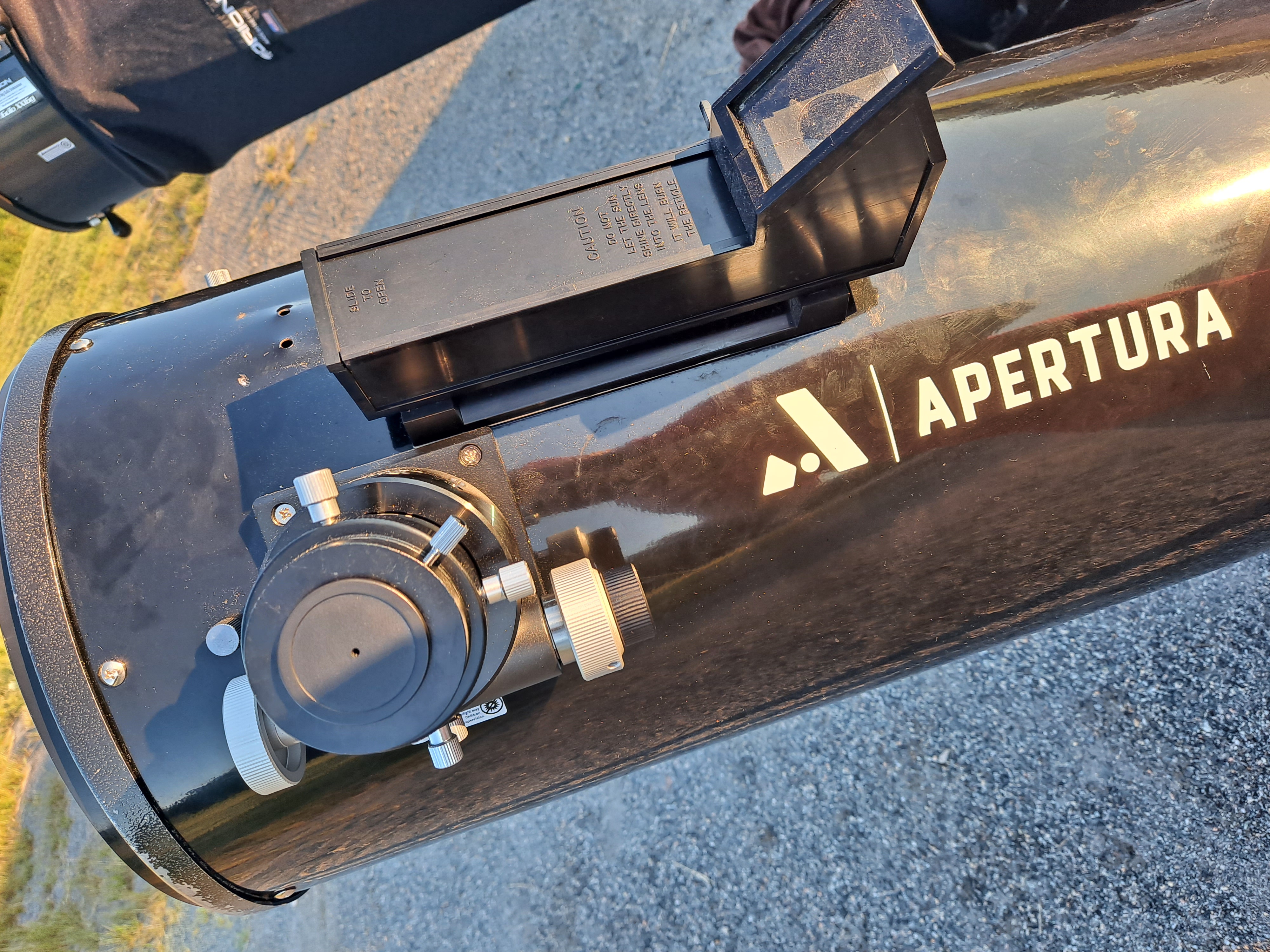Light pollution is a big hindrance to observing for people who live in cities. Light pollution filters may help in some situations.
Light pollution filters will help increase contrast and block out certain wavelengths of light. Expect to be able to see objects with greater clarity, more detail and contrast. Light pollution filters do not amplify the light entering the scope, they block out certain types of light. They don’t make the objects brighter, they make them more crisp.
Objects may appear brighter by making the background darker when observing with a light pollution filter.
Light pollution filters can be very expensive, my favorite filter was about $200. So, if possible go to an astronomy meet up and give it a try to be sure that you know what it will do for you. Expectations are so important. I use a Lumicon UHC filter, which is a type of light blocking filter and I do find that it creates a better observing picture.
Filters for astrophotography can be even more expensive, and more specialized. Be sure you are getting the right filter for your application and start with one and get the hang of it before you grow your collection.
My telescope came with a moon filter. This was a great way for me to see what a filter does and how it works. I think it is a good idea to play with an inexpensive filter before investing in a more specialized filter.
Here is a list of some very useful filters and their best uses. If you are looking to give one a try, some can be had for $10 -30. Try them out and see what they give you before investing in a $200 filter.
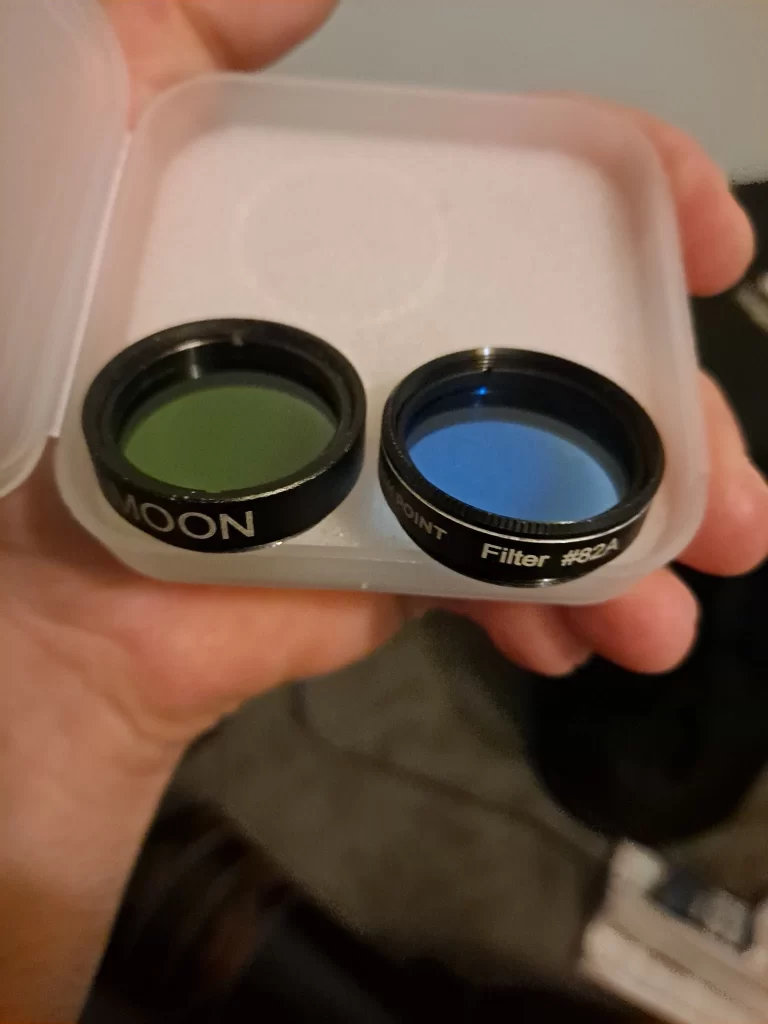
| Filter | Price | Best Use |
| Explore Scientific OIII Nebula Filter | 1.25 $$ 2 $$ | Observing planetary and emission nebula Do not use when observing galaxies |
| Lumicon UHC | 1.25 $$$2 $$$ | Nebula filter, passes 3 oxygen lines, blocks sky glow. Makes the background sky darker. Try with 8in or more aperture viewing Swang, Lagoon and Dumbell Nebula |
| Baader Moon and SkyGlow Filter | 1.25 $ 2 $ | Light polluted skies (streetlights) and planetary observing, blocks a large section of light wavelength but not all colors |
| Lumicon 82a Pale Blue | 1.25 $ 2 $ | Planetary and Lunar observing |
| Apertura Neutral Density | 1.25 $ 2 $ | Bright objects, like the moon and venus. Blocks 50% of light coming through eyepiece, but preserves colors, good for stacking |
| Orion Variable Polarizing | 1.25 $ 2 $ | Lunar and Planetary observing. Can be adjusted like a dimmer switch. |
Tips for Observing in Light Polluted Areas
If you regularly observe in light polluted skies it is important that you attend to all the basics.
This is a great list of things that you can do to get the best views possible in a light polluted area.
All of these strategies can be used in any Bortle area. Do not be discouraged if your bortle score is very high, you may be surprised at what you can see in a Bortle 6, 7 or 8. Give these all a try before you give up.
Dark Adapted Vision
It is important to keep your vision as fully dark adapted as possible. That means avoiding bright lights, especially screens for an hour or more before going out to observe.
Some people choose to wear a patch over their observing eye for some time before observing.
There is a great guide to dark adapted vision on this site that explains in depth how and why it works.
That guide will also help you determine how long it takes you to become fully dark adapted. That varies from person to person.
Light Blocking
When observing in heavily light polluted areas use a drape over your head. It can be as simple as a towel that you drape over your head.
Use something dark colored to block out ambient light from entering your scope.
Some people fashion a tube on the end of their telescope, like a dew shield, paint it black and it can help increase contrast by blocking some stray light from entering the optical tube.
Averted Vision
Averted vision is the practice of observing objects without looking directly at them.
You put a brighter object in the center of the field of view and observe a dimmer object without directly looking at it.
The way your vision works, the cells on the periphery of your vision are better at seeing detail in low light, this makes using averted vision beneficial when observing dim objects.
This takes practice and will feel very awkward at first, but it is something you can try before investing in expensive equipment.
Aperture
Although it is counterintuitive, using a smaller aperture telescope can make observing in light polluted skies better.
The larger your scope the more light it collects.
If you have all the light blocking in place and you are still struggling, see if you can try a smaller aperture, like an 8 inch Dobsonian and see what you get.
By nature they make some things more visible and some things less visible. The filter must block out certain kinds of light and some of that light is the kind you want to see.
When I was upgrading my telescope from a 10 inch to a 16 inch I was told on more than one occasion that a dark sky is better than a bigger scope. The larger scope just collects more of the light pollution.
I did experience this when I visited friends in rural Missouri. It was my first time in Bortle 1 skies and it was mesmerizing. I specifically remember M51 and Markarian’s Chain.
I am always wondering when I can get back there to observe. I am planning my next trip around the new moon.
Light Pollution Filters
If you have checked off all the boxes above, you may want to try a light pollution filter.
A light pollution filter works by blocking certain types of light and creating greater contrast. They do not
I have a UHC filter from Lumicon, I use it when I observe planetary nebulae and emission nebulae. Check out the t
The best filter is a tank of gas. There is no substitute for dark skies.
What is light pollution?
Light pollution is light from the earth that makes it harder to distinguish the light in the sky. Things like streetlights, house lights and headlights that reflect off the sky making it harder to see contrast with objects in the sky.
Bright objects in the sky that are close together can also produce light pollution that makes it hard to discern details.
Double stars where one is much brighter than the other can also benefit from the use of a light pollution filter.
Light pollution is measured on the Bortle Scale, you can find the level of light pollution where you live by searching on the light pollution atlas on this site https://www.lightpollutionmap.info/.
There is a saying in astronomy that the best filter is a tank of gas. This means that no filter will work as well as driving to a dark sky area. I travel when I observe 99% of the time, so I understand that moving your scope around all the time has some serious drawbacks, but it is worth the dark skies.
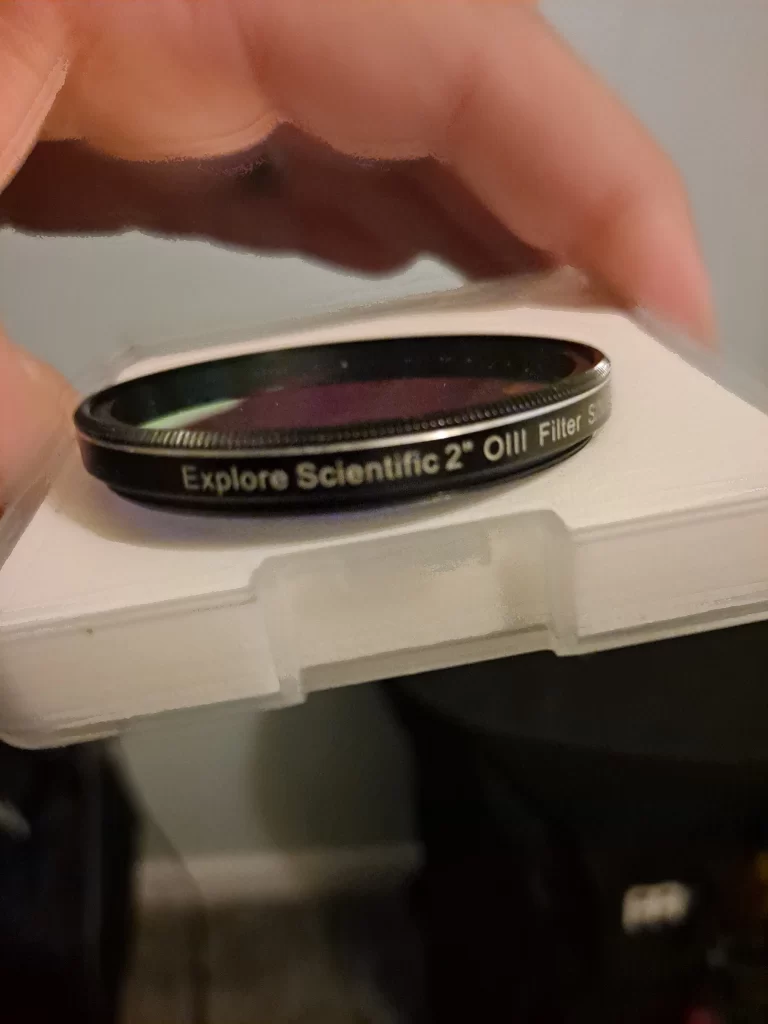
Do light pollution filters work?
Light pollution filters, color filters, oxygen filters will all manipulate the types and amount of light that you can observe with your telescope.
Light pollution filters do not make objects brighter, they make the background darker to create greater contrast. They will not allow you to see objects that you cannot see without a filter. They will amplify the views by blocking out light that is not coming from the nebula or planet you are trying to observe.
If you are considering a light pollution for your telescope, start with a moon filter so you can get an idea of what a filter can do for you.
After you have tried an inexpensive filter, plan a trip to the darkest skies possible. If you live on the East Coast, see if you can make it to Cherry Springs Park in Pennsylvania.
See what you get in a dark sky area and then make a very informed decision when you build your gear collection.
Filters are great tools for observing, but they are not magic.
When you start astrophotography filters can make a much bigger difference than they will with visual observing.
What is a UHC filter?
You will see a difference with a UHC filter. This is the only filter that I regularly use. This crosses the oxygen 3 and hydrogen beta lines. This means it allows those kinds of light through the filter by blocking most other wavelengths of light.
It works by creating greater contrast. It blocks the light that is coming from the sky background making objects brighter against it.
M42, M8, M17, M57 and M27 are all brighter when I observe them with my UHC filter.
